Introduction-of-Giant-Panda大熊猫英文介绍教学文稿
- 格式:ppt
- 大小:2.49 MB
- 文档页数:13
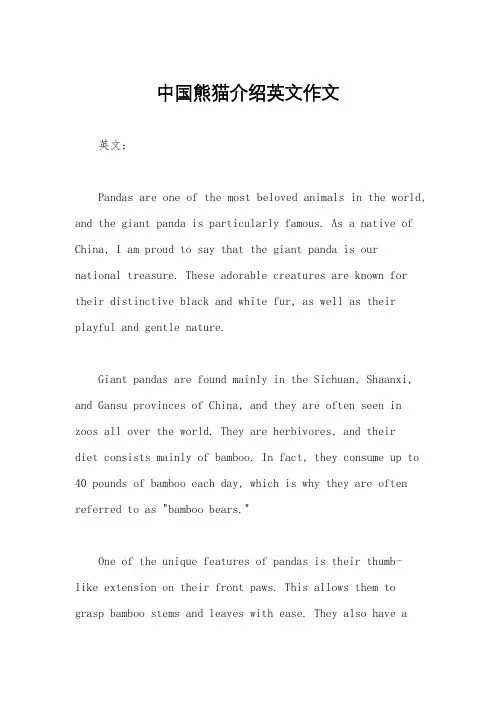
中国熊猫介绍英文作文英文:Pandas are one of the most beloved animals in the world, and the giant panda is particularly famous. As a native of China, I am proud to say that the giant panda is ournational treasure. These adorable creatures are known for their distinctive black and white fur, as well as their playful and gentle nature.Giant pandas are found mainly in the Sichuan, Shaanxi, and Gansu provinces of China, and they are often seen in zoos all over the world. They are herbivores, and theirdiet consists mainly of bamboo. In fact, they consume up to 40 pounds of bamboo each day, which is why they are often referred to as "bamboo bears."One of the unique features of pandas is their thumb-like extension on their front paws. This allows them to grasp bamboo stems and leaves with ease. They also have aspecial digestive system that allows them to break down the tough bamboo fibers and extract the nutrients they need.Pandas are also known for their slow reproductive rate. Female pandas only ovulate once a year, and they have a very short window of time in which they can conceive. Additionally, pandas have a high rate of infant mortality, which makes it even more difficult for them to reproduce.Despite their challenges, pandas are a symbol of hope and conservation. The Chinese government has taken great strides to protect these animals, and their population has been slowly increasing in recent years. In addition, many conservation organizations around the world are working to protect pandas and their habitats.中文:熊猫是世界上最受欢迎的动物之一,而大熊猫则尤为著名。
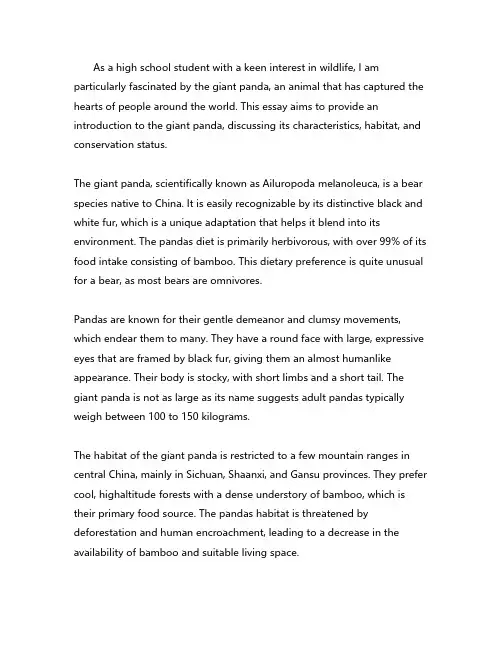
As a high school student with a keen interest in wildlife, I am particularly fascinated by the giant panda, an animal that has captured the hearts of people around the world. This essay aims to provide an introduction to the giant panda, discussing its characteristics, habitat, and conservation status.The giant panda, scientifically known as Ailuropoda melanoleuca, is a bear species native to China. It is easily recognizable by its distinctive black and white fur, which is a unique adaptation that helps it blend into its environment. The pandas diet is primarily herbivorous, with over 99% of its food intake consisting of bamboo. This dietary preference is quite unusual for a bear, as most bears are omnivores.Pandas are known for their gentle demeanor and clumsy movements, which endear them to many. They have a round face with large, expressive eyes that are framed by black fur, giving them an almost humanlike appearance. Their body is stocky, with short limbs and a short tail. The giant panda is not as large as its name suggests adult pandas typically weigh between 100 to 150 kilograms.The habitat of the giant panda is restricted to a few mountain ranges in central China, mainly in Sichuan, Shaanxi, and Gansu provinces. They prefer cool, highaltitude forests with a dense understory of bamboo, which is their primary food source. The pandas habitat is threatened by deforestation and human encroachment, leading to a decrease in the availability of bamboo and suitable living space.One of the most remarkable aspects of the giant panda is its status as a living fossil. Fossil records suggest that the pandas ancestors lived over 8 million years ago, during the late Miocene epoch. Despite the passage of time and the changing environment, the panda has managed to survive, albeit with a dwindling population.The giant panda is listed as an endangered species by the International Union for Conservation of Nature IUCN. The main threats to its survival include habitat loss, poaching, and a low reproductive rate. In the wild, there are estimated to be fewer than 2,000 giant pandas, and their numbers continue to decline.Conservation efforts for the giant panda have been ongoing for several decades. The Chinese government has established nature reserves to protect the pandas habitat and has implemented laws to prevent poaching. Additionally, captive breeding programs have been successful in increasing the panda population. These programs involve breeding pandas in captivity and then releasing them into the wild to boost the overall population.The giant panda has also become a symbol of international cooperation in conservation. The World Wildlife Fund WWF adopted the panda as its logo in 1961, and the panda has since become a global ambassador for wildlife conservation. Many countries around the world have welcomed giant pandas into their zoos, which helps raise awareness about the pandas plight and generates funds for conservation efforts.In conclusion, the giant panda is a remarkable species with a unique appearance, diet, and behavior. Its status as an endangered species highlights the importance of conservation efforts to protect this beloved animal. As a high school student, I am inspired by the resilience of the giant panda and the dedication of conservationists who work tirelessly to ensure its survival. It is my hope that through continued efforts, the giant panda will continue to thrive in its natural habitat for generations to come.。
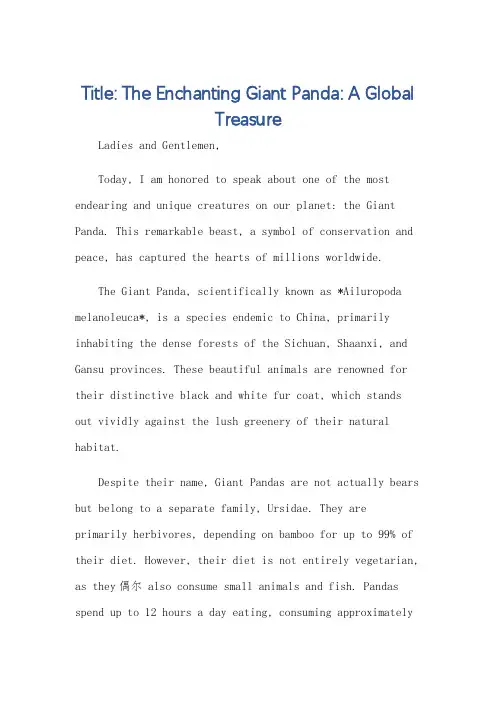
Title: The Enchanting Giant Panda: A GlobalTreasureLadies and Gentlemen,Today, I am honored to speak about one of the most endearing and unique creatures on our planet: the Giant Panda. This remarkable beast, a symbol of conservation and peace, has captured the hearts of millions worldwide.The Giant Panda, scientifically known as *Ailuropoda melanoleuca*, is a species endemic to China, primarily inhabiting the dense forests of the Sichuan, Shaanxi, and Gansu provinces. These beautiful animals are renowned for their distinctive black and white fur coat, which stands out vividly against the lush greenery of their natural habitat.Despite their name, Giant Pandas are not actually bears but belong to a separate family, Ursidae. They areprimarily herbivores, depending on bamboo for up to 99% of their diet. However, their diet is not entirely vegetarian, as they偶尔 also consume small animals and fish. Pandas spend up to 12 hours a day eating, consuming approximately30 kilograms of bamboo to meet their nutritional requirements.What truly sets the Giant Panda apart is their unusual lifestyle. These creatures are semi-arboreal, meaning they spend considerable time in trees, climbing, resting, and even giving birth. Pandas are also known for their slow and relaxed pace of life, often spending hours simply sitting and chewing on bamboo.Unfortunately, the Giant Panda is listed as a Vulnerable species on the IUCN Red List, primarily due to habitat loss and degradation. In response, conservation efforts have been intensified, including the establishment of nature reserves, public awareness campaigns, and captive breeding programs. These initiatives have been successful, and the panda population is now estimated to be over 2,200 individuals, with more than 600 living in captivity.The Giant Panda is not just a species; it's a symbol of hope and a reminder of our responsibility towards conservation. Their conservation efforts have become a global movement, with people from all over the world coming together to protect this charismatic creature.In conclusion, the Giant Panda is a remarkabletestament to the diversity and beauty of life on our planet. They are not just a species in need of protection; they are a symbol of unity and conservation efforts that span the globe. As we move forward, let us remember the lessons taught by the Giant Panda and strive to protect the natural world that we all share.Thank you.**大熊猫:全球珍宝的迷人之处**女士们、先生们:今天,我非常荣幸地向大家介绍地球上最可爱、最独特的生物之一:大熊猫。
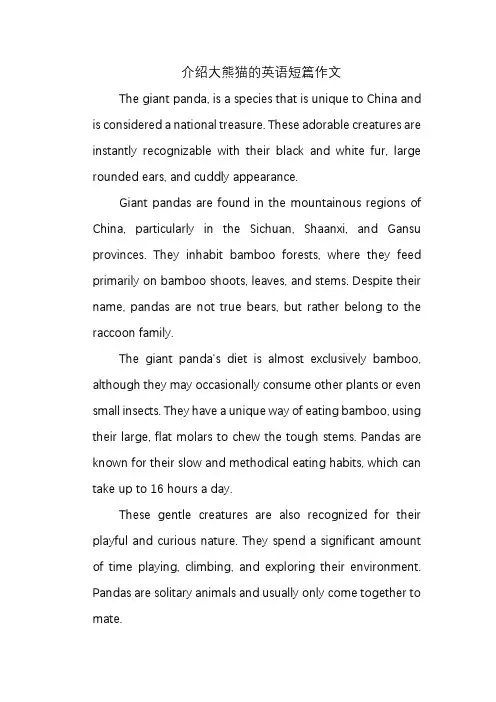
介绍大熊猫的英语短篇作文The giant panda, is a species that is unique to China and is considered a national treasure. These adorable creatures are instantly recognizable with their black and white fur, large rounded ears, and cuddly appearance.Giant pandas are found in the mountainous regions of China, particularly in the Sichuan, Shaanxi, and Gansu provinces. They inhabit bamboo forests, where they feed primarily on bamboo shoots, leaves, and stems. Despite their name, pandas are not true bears, but rather belong to the raccoon family.The giant panda's diet is almost exclusively bamboo, although they may occasionally consume other plants or even small insects. They have a unique way of eating bamboo, using their large, flat molars to chew the tough stems. Pandas are known for their slow and methodical eating habits, which can take up to 16 hours a day.These gentle creatures are also recognized for their playful and curious nature. They spend a significant amount of time playing, climbing, and exploring their environment. Pandas are solitary animals and usually only come together to mate.Giant pandas are an endangered species, with only about 1,800 individuals remaining in the wild. The Chinese government and various conservation organizations have implemented programs to protect and breed pandas, with some success. Today, there are more pandas in captivity than in the wild, but efforts are still ongoing to ensure their survival.In conclusion, the giant panda is a symbol of China's rich biodiversity and cultural heritage. With their endearing appearance and unique lifestyle, pandas continue to capture the hearts of people around the world. Efforts to protect and preserve these incredible creatures are crucial for future generations to enjoy.中文翻译:大熊猫,是一种独特于中国的物种,被认为是国家宝藏。
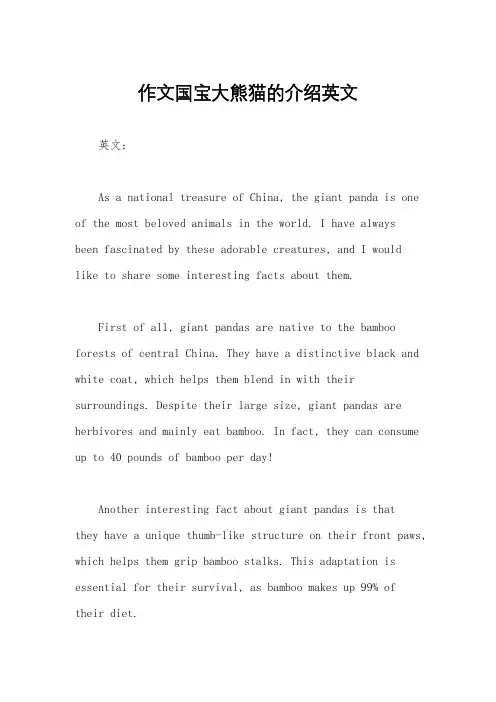
作文国宝大熊猫的介绍英文英文:As a national treasure of China, the giant panda is one of the most beloved animals in the world. I have alwaysbeen fascinated by these adorable creatures, and I wouldlike to share some interesting facts about them.First of all, giant pandas are native to the bamboo forests of central China. They have a distinctive black and white coat, which helps them blend in with their surroundings. Despite their large size, giant pandas are herbivores and mainly eat bamboo. In fact, they can consume up to 40 pounds of bamboo per day!Another interesting fact about giant pandas is thatthey have a unique thumb-like structure on their front paws, which helps them grip bamboo stalks. This adaptation is essential for their survival, as bamboo makes up 99% oftheir diet.Unfortunately, giant pandas are an endangered species, with only around 1,800 left in the wild. This is due to habitat loss and fragmentation, as well as poaching. However, conservation efforts have been successful inrecent years, and the population is slowly increasing.In conclusion, giant pandas are truly amazing animals that deserve our love and protection. I hope that bylearning more about them, we can all appreciate theirbeauty and importance in the natural world.中文:作为中国的国宝,大熊猫是世界上最受欢迎的动物之一。


介绍大熊猫的英语作文Introduction to Giant Pandas。
Giant pandas, also known as panda bears, are one of the most beloved and iconic animals in the world. These adorable creatures are native to central China, where they live in the bamboo forests of the Sichuan, Shaanxi, and Gansu provinces. In this article, we will take a closer look at the physical characteristics, behavior, habitat, and conservation status of giant pandas.Physical Characteristics。
Giant pandas are easily recognizable by theirdistinctive black and white fur. Their fur is thick and woolly, which helps them stay warm in the cool mountain forests where they live. The black and white fur pattern is thought to help them blend in with their surroundings and avoid predators. Adult giant pandas can weigh up to 330 pounds (150 kilograms) and stand up to 4 feet (1.2 meters)tall at the shoulder. They have a round face, short snout, and large, round ears.Behavior。

成都大熊猫基地英文导游词 Did you work harder today, April 6th, 2023Good morning, Ladies and gentlemen. Welcome to Chengdu Research Base of Giant Panda Breeding.You know, The base is the best destination to know the giant pandas. Here we can closely observe pandas ,how they rest, eat and play with each other, also, we can learn how to feed them, even we can watch female pandas nursing their cubs . And more importantly, we can further our understanding of how to protect these beautiful but endangered creatures.Ladies and gentlemen, now we are at the Adult Panda Enclosure.Look, there are two giant pandas just coming out from their house. The bigger one is Huanhuan, a male panda. And the smaller one is Xixi, a female panda. Both of them are 4 years old. You know we are very lucky today, because usually at this time they were still in they are walking towards the fresh bamboo ,it seems that they are going to have their breakfast.Now while we watch them eat, let me introduce their eating habit to you.We all know that giant pandas are famous for their love of bamboo. But do you know how much bamboo a giant panda eats a day 5kg, 8, 10 Actually, for an adult panda, it eats about 17kg of bamboo stems a day or 14kg of bamboo leaves, or about 40kg of bamboo shoots. That’s quitea huge amount, right So giant pandas almost spend 12-16 hours eating bamboo each day.And now you may ask why they need to eat so much bamboo That’s because bamboo has very little nutritional value, so pandas must eat a lot to meet their energy , to reduce their energy consumption, pandas spend about 10 hours on sleeping everyday. That’s why the time left for them to play is very little.Everybody, here comes a confusing question, are giant pandas herbivores No, there are not herbivores. Although they depend so much on bamboo and only about 1% of their diet is made up of other foods., Giant pandas are members of the bear family; they have the same digestive structure of carnivores.In some ways, they are anomalies of evolution. They are descended from meat-loving carnivores. In other words, their digestive tract is built to break down meat and is inadequate to break down bamboo. So pandas can only get small amount of nutrition from bamboo. That’s another reason why giant pandas have to eat lots of bamboo .The fact is startling, right Pandas still eat meat occasionally when it’s available. But maybe because bamboo is easy to get year-round so evolution favored pandas that rely on bamboo. For whatever reason, after thousands of years of eating bamboo, they like it more and more, so much so that they prefer it than any other food.Now, ladies and gentlemen, we have learned why giant pandas need to eat a lot of bamboo every day. Next I am now going to show you how female pandas feed their cubs. Please follow me. We are going to the next site, the giant panda nursing facilities. Thanks。

介绍熊猫的英语文章以下是关于熊猫的英语文章、释义、短语、单词、用法和双语例句:**文章:**The Giant PandaThe giant panda is one of the most beloved and iconic animals in the world. Pandas are native to China and are known for their unique appearance and charming behavior.Pandas have a distinctive black and white fur pattern. Their round faces, black eyes, and fluffy bodies make them incredibly cute. These gentle giants mainly eat bamboo, spending most of their day chewing and consuminglarge amounts of this plant.Pandas are endangered species due to habitat loss and low reproduction rates. However, efforts by the Chinese government and conservation organizations have helped increase their population in recent years.Conservation of pandas is of great significance as they are not only precious animals but also symbols of global biodiversity and conservation efforts.**单词和释义:**1. **Giant Panda** :大熊猫2. **Iconic** :标志性的;偶像的3. **Native** :本土的;原产的4. **Distinctive** :独特的;与众不同的5. **Fur** :毛皮6. **Charming** :迷人的;可爱的7. **Endangered** :濒危的8. **Habitat** :栖息地9. **Reproduction** :繁殖;生殖10. **Conservation** :保护;保存**短语:**1. Be known for :因...而闻名2. Low reproduction rate :低繁殖率3. Of great significance :具有重大意义4. Bamboo shoot :竹笋5. Live in :居住在6. Look cute :看起来可爱7. Be native to :原产于8. Make efforts :努力9. Protect the environment :保护环境10. Global biodiversity :全球生物多样性**用法和双语例句:**1. “Iconic” :The Eiffel Tower is an iconic symbol of Paris. (埃菲尔铁塔是巴黎的标志性象征。
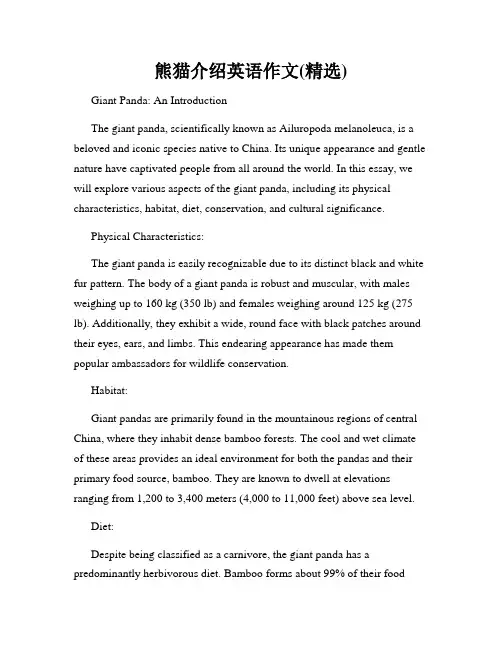
熊猫介绍英语作文(精选)Giant Panda: An IntroductionThe giant panda, scientifically known as Ailuropoda melanoleuca, is a beloved and iconic species native to China. Its unique appearance and gentle nature have captivated people from all around the world. In this essay, we will explore various aspects of the giant panda, including its physical characteristics, habitat, diet, conservation, and cultural significance.Physical Characteristics:The giant panda is easily recognizable due to its distinct black and white fur pattern. The body of a giant panda is robust and muscular, with males weighing up to 160 kg (350 lb) and females weighing around 125 kg (275 lb). Additionally, they exhibit a wide, round face with black patches around their eyes, ears, and limbs. This endearing appearance has made them popular ambassadors for wildlife conservation.Habitat:Giant pandas are primarily found in the mountainous regions of central China, where they inhabit dense bamboo forests. The cool and wet climate of these areas provides an ideal environment for both the pandas and their primary food source, bamboo. They are known to dwell at elevations ranging from 1,200 to 3,400 meters (4,000 to 11,000 feet) above sea level.Diet:Despite being classified as a carnivore, the giant panda has a predominantly herbivorous diet. Bamboo forms about 99% of their foodintake. They have a specialized wrist bone, called a "pseudo-thumb," which helps them grasp bamboo stalks efficiently. Adult pandas consume around 12 to 38 kg (26 to 84 lb) of bamboo shoots daily to meet their nutritional requirements. In a year, this amounts to consuming as much as 14,000 kg (30,000 lb) of bamboo.Conservation:Due to habitat destruction and poaching, giant pandas have faced significant challenges to their survival. However, efforts have been made to protect and conserve this endangered species. The Chinese government has established numerous nature reserves and enacted strict laws to safeguard the pandas and their habitat. International organizations, such as the World Wildlife Fund (WWF), also actively contribute to panda conservation through research, community engagement, and raising public awareness.Furthermore, breeding programs have been successful in increasing the population of giant pandas in captivity. These programs aim to reintroduce the captive-bred pandas into the wild, ensuring the survival of the species. The conservation efforts have yielded positive results, with the International Union for Conservation of Nature (IUCN) recently downgrading the giant panda's status from "endangered" to "vulnerable."Cultural Significance:In addition to their ecological importance, giant pandas hold significant cultural value. They are considered a national treasure in China and are often referred to as the country's "living treasures." Giant pandas are associated with peace, harmony, and resilience in Chinese culture. They have been recognized as a symbol of diplomacy, with several countries receivingpandas as diplomatic gifts. These gentle creatures have the power to bridge cultural gaps and foster international cooperation.In conclusion, the giant panda is a fascinating and cherished species that has captured the hearts of people worldwide. Its distinctive appearance, habitat, diet, conservation efforts, and cultural significance all contribute to its unique appeal. As we continue to work towards the protection and preservation of these incredible creatures, we ensure that future generations can marvel at the wonders of the giant panda.。
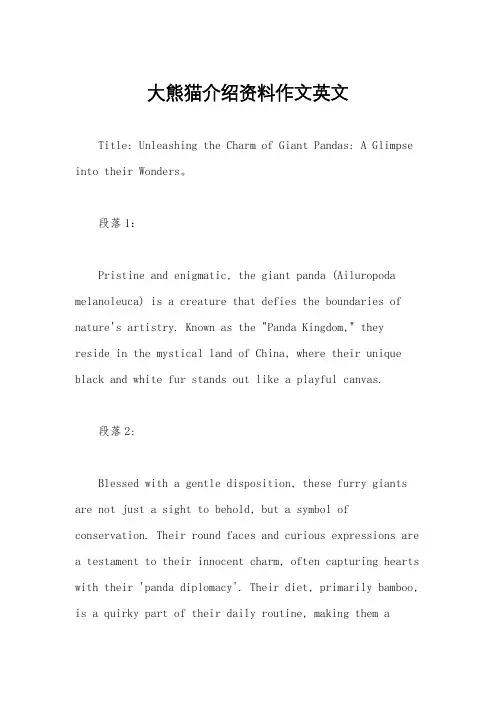
大熊猫介绍资料作文英文Title: Unleashing the Charm of Giant Pandas: A Glimpse into their Wonders。
段落1:Pristine and enigmatic, the giant panda (Ailuropoda melanoleuca) is a creature that defies the boundaries of nature's artistry. Known as the "Panda Kingdom," they reside in the mystical land of China, where their unique black and white fur stands out like a playful canvas.段落2:Blessed with a gentle disposition, these furry giants are not just a sight to behold, but a symbol of conservation. Their round faces and curious expressions are a testament to their innocent charm, often capturing hearts with their 'panda diplomacy'. Their diet, primarily bamboo, is a quirky part of their daily routine, making them adietary anomaly in the animal kingdom.段落3:The giant panda's habitat, the bamboo forest, is a sanctuary where they thrive. These dense forests provide them with the perfect blend of seclusion and sustenance. Their slow movements, often described as 'dignified slumber,' are a reminder of their relaxed lifestyle, far from the hustle and bustle of the world.段落4:Despite their solitary nature, pandas are no strangers to social interactions. They occasionally engage in play, particularly with their cubs, teaching them essential survival skills. Their unique 'hug' gesture, where they wrap their arms around a bamboo stalk, is a charming adaptation to their bamboo-centric lifestyle.段落5:The conservation efforts for these beloved creaturesare a testament to humanity's commitment to preserving biodiversity. Their conservation status, listed as'vulnerable,' is a call to action, urging us to respect and protect their fragile habitat. As we marvel at their antics, let's remember that every panda is a precious reminder of the importance of conservation.In conclusion, the giant panda, with its captivating appearance and unique lifestyle, is a living embodiment of nature's wonders. Their story, a blend of mystery, charm, and conservation, is a lesson we can all learn from. So, next time you encounter a panda, cherish the moment, forit's a fleeting encounter with a creature that timelessly captivates.。
介绍熊猫的基本情况英语作文Title:The Enchanting Giant PandaThe Giant Panda,a national treasure of China and a global icon of conservation,is a species that captivates the world with its unique charm.Native to the dense forests of central China,particularly the Sichuan,Shaanxi,and Gansu provinces,the panda inhabits a narrow range of mountainous habitats.Physically,the panda is a striking creature,with its signature black and white fur coat.Its round body,short legs,and large,black patches around its eyes give it a charming,almost comical appearance.Despite its size,the panda is an agile tree climber,using its sharp claws to scale branches effortlessly.The panda's diet is surprisingly unique,consisting almost entirely of bamboo.Despite its carnivore classification,the panda's diet consists of over 99%bamboo,with the remaining 1%consisting of small amounts of grass,roots,vegetables,and occasionally,fish,birds,and insects.This bamboo-heavy diet requires the panda to consume up to 30 kilograms of bamboo per day to meet its nutritional needs.The panda's reproduction rate is slow,with female pandastypically giving birth to only one or two cubs every two to three years.These cubs remain with their mothers for up to a year,learning vital survival skills such as climbing trees and finding food.Due to this slow reproduction rate and their specific habitat requirements,the panda is classified as a vulnerable species by the International Union for Conservation of Nature(IUCN).To protect the panda and its habitat,conservation efforts have been ongoing for decades.China has established several nature reserves,including the Wolong Nature Reserve in Sichuan,specifically to protect and preserve the panda's natural habitat.Additionally,global cooperation and awareness-raising campaigns have helped to raise funds and awareness for panda conservation.In conclusion,the Giant Panda is a remarkable species,unique in both its appearance and its ecological importance.Its survival depends on our continued efforts to protect its habitat and ensure its long-term viability.As we learn more about this enchanting creature,we are reminded of the importance of conservation and the role we all play in protecting the world's natural wonders.。
大熊猫介绍资料作文英文英文:The giant panda, also known as the panda bear, is a beloved and iconic symbol of China. These adorablecreatures are known for their distinctive black and white fur, as well as their playful and gentle nature. I have always been fascinated by these incredible animals, and I would love to share some interesting information about them.Giant pandas are native to China and can be found inthe mountain ranges of Sichuan, Shaanxi, and Gansu provinces. They primarily inhabit dense bamboo forests, where they feed almost exclusively on bamboo. In fact, bamboo makes up 99% of their diet! This unique diet has led to some fascinating adaptations in the panda's digestive system, allowing them to efficiently process and extract nutrients from bamboo.In addition to their diet, giant pandas are also knownfor their distinctive physical features. Their large, round heads and black patches around their eyes and ears givethem a charming and endearing appearance. They are also known for their gentle temperament and playful behavior, making them a favorite among animal lovers around the world.One of the most interesting facts about giant pandas is their conservation status. Due to habitat loss and poaching, giant pandas were once on the brink of extinction. However, thanks to dedicated conservation efforts and breeding programs, their population has been slowly recovering. In 2016, the International Union for Conservation of Nature (IUCN) reclassified the giant panda from "endangered" to "vulnerable," marking a significant milestone in their conservation journey.In conclusion, giant pandas are truly remarkable creatures that hold a special place in the hearts of people around the world. Their unique diet, physical features, and conservation status make them a fascinating subject ofstudy and admiration.中文:大熊猫,也被称为熊猫熊,是中国的标志性动物。
简要介绍大熊猫英语作文Title: The Enigmatic Giant Panda: A Symbol of Conservation Efforts。
The giant panda, scientifically known as Ailuropoda melanoleuca, is a charismatic and iconic species native to the bamboo forests of China. Renowned for its distinctive black and white fur, the giant panda is not only a national treasure of China but also a symbol of global conservation efforts.First and foremost, the giant panda's unique appearance captivates the hearts of people worldwide. With its large, round eyes accentuated by black patches around them and its endearing chubby cheeks, the panda exudes an aura of innocence and charm. Its black and white fur, arranged in patches across its body, serves as effective camouflage in its natural habitat of dense bamboo forests.Moreover, the giant panda's diet is primarily composedof bamboo shoots and leaves, although it occasionally consumes small rodents or carrion. This specialization in bamboo consumption sets it apart from other bear species and underscores its dependence on specific habitat types. Unfortunately, the limited availability of bamboo forests due to human activities such as deforestation poses a significant threat to the panda's survival.Despite being classified as a carnivore, the giant panda has a digestive system adapted to a herbivorous diet. Its pseudo-thumb, formed from an elongated wrist bone, aids in grasping bamboo stems and stripping leaves from them. This adaptation highlights the evolutionary ingenuity of the panda in adapting to its bamboo-rich environment.Furthermore, the reproductive behavior of giant pandas is both fascinating and challenging for conservationists. Female pandas are fertile for only two to three days per year, making successful mating and reproduction a rare occurrence. Additionally, captive breeding programs face obstacles such as low reproductive rates and difficulties in artificial insemination. However, efforts byconservation organizations and zoos worldwide have led to significant breakthroughs in giant panda breeding, contributing to the species' conservation.Conservation initiatives aimed at protecting the giant panda and its habitat have gained global attention and support. China's establishment of nature reserves specifically for giant pandas, such as the Wolong National Nature Reserve and the Chengdu Research Base of Giant Panda Breeding, demonstrates a commitment to safeguarding this endangered species. Moreover, international collaborations and partnerships have enabled the exchange of expertise and resources for panda conservation.In recent years, advancements in technology, such as GPS tracking and remote sensing, have facilitated monitoring efforts to study panda behavior and habitat use more comprehensively. This data-driven approach provides valuable insights for conservation strategies aimed at mitigating threats to the panda's survival.In conclusion, the giant panda serves as a symbol ofhope and resilience in the face of environmental challenges. Through concerted conservation efforts and public awareness campaigns, we can ensure the long-term survival of this beloved species and preserve the rich biodiversity of our planet for future generations. The story of the giant panda exemplifies the importance of global cooperation in protecting endangered species and their habitats.。
介绍熊猫的资料英语作文Title: The Giant Panda: A Symbol of Conservation。
The giant panda, scientifically known as Ailuropoda melanoleuca, is one of the most beloved and iconic species in the world. Renowned for its distinctive black-and-white fur, endearing appearance, and gentle demeanor, the panda holds a special place in both the hearts of people worldwide and the realm of conservation efforts. In this essay, we will explore various aspects of the giant panda, including its habitat, diet, conservation status, and significance.Habitat and Distribution:Giant pandas are native to China and are primarily found in the mountainous regions of Sichuan, Shaanxi, and Gansu provinces. They inhabit dense bamboo forests at elevations between 5,000 and 10,000 feet (1,500 to 3,000 meters) above sea level. These regions provide the pandaswith the bamboo they rely on for sustenance, as well as the seclusion they need for their solitary lifestyle.Diet:The giant panda is a specialized herbivore, with bamboo constituting over 99% of its diet. Despite being classified as carnivores, pandas have evolved to subsist almost entirely on bamboo due to its abundance in their habitat. They possess a unique anatomical adaptation in their digestive system, including a pseudo thumb formed from an enlarged wrist bone, which aids in grasping bamboo stems and stripping leaves. Despite their preference for bamboo, pandas may also consume small rodents, birds, or carrion opportunistically.Reproduction:Giant pandas are solitary animals, with individuals coming together primarily during the breeding season. Female pandas are fertile for only a few days each year, usually in the spring. Mating behaviors involve elaboraterituals, including scent marking and vocalizations. After a gestation period of around five months, females give birth to one or two cubs, although twins are relatively rare. Panda cubs are born blind and helpless, weighing only about 100 grams at birth. Mothers care for their offspring diligently, often cradling them in their arms for extended periods.Conservation Status:Despite their cultural significance and global popularity, giant pandas face numerous threats to their survival. Habitat destruction, primarily due to deforestation and human encroachment, remains the most significant threat to panda populations. Additionally, climate change poses a growing concern, as it alters bamboo distribution and exacerbates natural disasters such as wildfires and landslides. Furthermore, poaching and illegal wildlife trade, although significantly reduced in recent years, still pose a threat to these vulnerable creatures.Conservation Efforts:Recognizing the urgent need to protect giant pandas and their habitat, both governmental and non-governmental organizations have implemented various conservation initiatives. These efforts include the establishment of protected areas, such as nature reserves and national parks, dedicated to panda conservation. Furthermore, collaborative research projects have been launched to study panda behavior, reproduction, and genetics, providing valuable insights for conservation strategies. Captive breeding programs have also played a crucial role in boosting panda populations and genetic diversity, with successful reintroduction programs aimed at restoring pandapopulations in the wild.Significance and Cultural Importance:Giant pandas hold immense cultural significance, both within China and globally. As a national treasure of China, pandas are often regarded as symbols of peace, friendship, and environmental conservation. They have become ambassadors for wildlife conservation efforts worldwide,serving as charismatic flagship species for raising awareness about the plight of endangered animals and the importance of biodiversity conservation. Through their widespread appeal, pandas have inspired countless individuals, organizations, and governments to take action to protect not only pandas themselves but also their habitats and the ecosystems they inhabit.In conclusion, the giant panda represents not only a charismatic and beloved species but also a symbol of hope and resilience in the face of environmental challenges. Through concerted conservation efforts and global cooperation, we can ensure the survival of these iconic creatures for generations to come, preserving not only a species but also the rich biodiversity and natural heritage of our planet.。
关于熊猫的英语演讲稿我喜欢的动物熊猫英语演讲稿演讲稿也叫演讲词,它是在较为隆重的仪式上和某些公众场合发表的讲话文稿。
演讲稿是进行演讲的依据,是对演讲内容和形式的规范和提示,它体现着演讲的目的和手段。
演讲稿是人们在工作和社会生活中经常使用的一种文体。
下面是关于熊猫的英语演讲稿请参考. 关于熊猫的英语演讲稿The giant panda (Ailuropoda melanoleuca) (“black-and-white cat-foot”) is a mammal classified in the bear family, Ursidae, native to central-western and southwestern China.It is easily recognized by its large, distinctive black patches around the eyes, ears and on its rotund body.Though technically a carnivore, the panda has a diet which is 98% bamboo.However, they may eat other foods such as honey, eggs, fish, and yams. The Giant Panda is an endangered animal; an estimated 3,000 pandas live in the wild and over 180were reported to live in captivity by August 20__ in mainland China (another source by the end of 20__ put the figure for China at 221), with twenty pandasliving outside of China.[citation needed] However, reports show that the numbers of wild panda are on the rise. The giant panda has long been a favorite of the public, at least partly on account of the factthat the species has an appealing baby-like cuteness that makes it seem to resemble a living teddy bear.The fact that it is usually depicted reclining peacefully eating bamboo, as opposed to hunting, also adds to its image of innocence.Though the giant panda is often assumed docile because of their cuteness, they have been known to attack humans, usually assumed to be out of irritation rather than predatory behavior. The Giant Panda has a very distinctive black-and-white coat.Adults measure around 1.5 m long and around 75 cm tall at the shoulder.Males can weigh up to 115 kg (253 pounds).Females are generally smaller than males, and can occasionally weigh up to 100 kg (220 pounds).Giant Pandas live in mountainous regions, such as Sichuan,Gansu, Shaan____i, and Tibet.While the Chinese dragon has been historically a national emblem for China, since the latter half of the 20th century the Giant Panda has also bee an informal national emblem for China.Its image appears on a large number of modern Chinese memorative silver, gold, and platinum coins. The Giant Panda has an unusual paw, with a “thumb” and five fingers; the “thumb” is actually a modified sesamoid bone, which helps the panda to hold the bamboo while eating.Stephen Jay Gould wrote an essay about this, then used the title The Panda's Thumb for a book of essays concerned with evolution and intelligent design.The Giant Panda has a short tail, appro____imately 15 cm long.Giant Pandas can usually live to be 20-30 years old while living in captivity. Until recently, scientists thought giant pandas spent most of their lives alone, with males and females meeting only during the breeding season.Recent studies paint a different picture, in which small groups of pandas share a large territory and sometimes meet outside the breeding season.[citation needed]Like most subtropical mammals, but unlike most bears, the giant panda does not hibernate. Diet Pandas eating bamboo at the National Zoo in Washington, D.C.Despite its ta____onomicclassification as a carnivore, the panda has a diet that is primarily herbivorous, which consists almost e____clusively of bamboo.This is an evolutionarily recent adaptation.Pandas lack the proper enzymes to digest bamboo efficiently, and thus derive little energy and little protein from it. While primarily herbivorous, the panda still retains decidedly ursine teeth, and will eat meat, fish, and eggs when available.In captivity, zoos typically maintain the pandas' bamboo diet, though some will provide specially formulated biscuits or other dietary supplements. 大熊猫(Ailuropoda melanoleuca),通常称熊猫,是属于熊科的一种哺乳动物,体色为黑白两色。